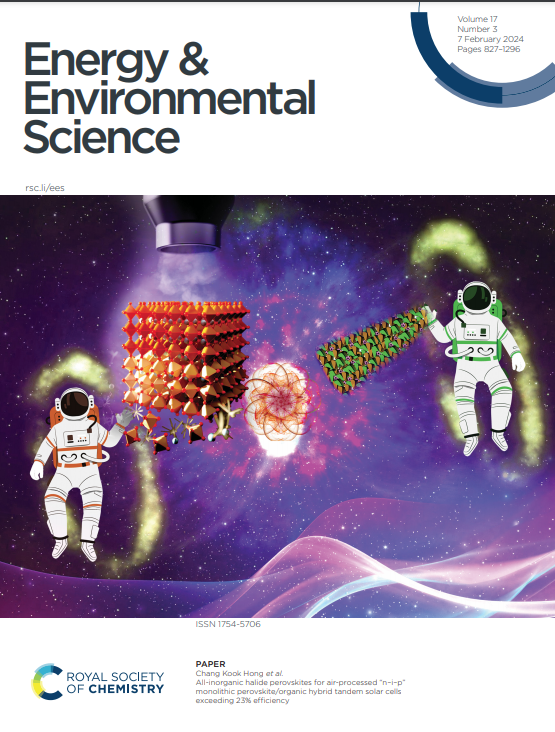Three-Step Thermodynamic vs. Two-Step Kinetics-Limited Sulfur Reactions in All-Solid-State Sodium Batteries
IF 32.4
1区 材料科学
Q1 CHEMISTRY, MULTIDISCIPLINARY
引用次数: 0
Abstract
The investigation of all-solid-state sodium-sulfur batteries (ASSSBs) is still in its early stage, where the intermediates and mechanism of the complex 16-electron conversion reaction of the sulfur cathode remain unclear. Herein, this study for the first time presents a comprehensive investigation of the sulfur reaction mechanism in ASSSBs by combining electrochemical measurements, ex-situ synchrotron X-ray absorption spectroscopy (XAS), in-situ Raman spectroscopy, and first-principles calculations. The sulfur cathode undergoes a three-step solid-solid redox reaction following the thermodynamic principle. S8 first reduces to long-chain polysulfides, Na2S5 and Na2S4, then to Na2S2, and finally to Na2S, resulting in a three-plateau voltage profile when temperatures ≥ 90°C or C-rates ≤ C/100. However, under kinetics-limited conditions, temperatures ≤ 60°C and C-rates ≥ C/20, the Na2S2 phase is skipped, leading to a direct conversion from Na2S4 to Na2S and resulting a two-plateau voltage profile. First-principles calculations reveal that the formation energy of Na2S2 is only 4 meV/atom lower than the two-phase equilibrium of Na2S4 and Na2S, explaining its absence under kinetics-limited conditions. This work clarified the thermodynamic and kinetics-limited pathways of the 16-electron conversion reaction of the sulfur cathode in ASSSBs, thereby facilitating the development of high-performance ASSSBs.全固态钠电池中的三步热力学与两步动力学限制硫反应
全固态钠硫电池(ASSSBs)的研究仍处于早期阶段,硫阴极复杂的 16 电子转换反应的中间产物和机理仍不清楚。在此,本研究首次结合电化学测量、原位同步辐射 X 射线吸收光谱(XAS)、原位拉曼光谱和第一原理计算,对 ASSSBs 中的硫反应机理进行了全面研究。硫阴极按照热力学原理进行了三步固-固氧化还原反应。S8 首先还原成长链多硫化物、Na2S5 和 Na2S4,然后还原成 Na2S2,最后还原成 Na2S,从而在温度≥ 90°C 或 C 速率≤ C/100 时产生三高原电压曲线。然而,在动力学限制条件下,即温度≤60°C 和 C 速率≥C/20 时,Na2S2 阶段被跳过,导致 Na2S4 直接转化为 Na2S,从而产生双波峰电压曲线。第一原理计算显示,Na2S2 的形成能仅比 Na2S4 和 Na2S 的两相平衡能低 4 meV/原子,这就解释了在动力学限制条件下没有 Na2S2 的原因。这项工作阐明了 ASSSB 中硫阴极 16 电子转换反应的热力学和动力学限制途径,从而促进了高性能 ASSSB 的开发。
本文章由计算机程序翻译,如有差异,请以英文原文为准。
求助全文
约1分钟内获得全文
求助全文
来源期刊

Energy & Environmental Science
化学-工程:化工
CiteScore
50.50
自引率
2.20%
发文量
349
审稿时长
2.2 months
期刊介绍:
Energy & Environmental Science, a peer-reviewed scientific journal, publishes original research and review articles covering interdisciplinary topics in the (bio)chemical and (bio)physical sciences, as well as chemical engineering disciplines. Published monthly by the Royal Society of Chemistry (RSC), a not-for-profit publisher, Energy & Environmental Science is recognized as a leading journal. It boasts an impressive impact factor of 8.500 as of 2009, ranking 8th among 140 journals in the category "Chemistry, Multidisciplinary," second among 71 journals in "Energy & Fuels," second among 128 journals in "Engineering, Chemical," and first among 181 scientific journals in "Environmental Sciences."
Energy & Environmental Science publishes various types of articles, including Research Papers (original scientific work), Review Articles, Perspectives, and Minireviews (feature review-type articles of broad interest), Communications (original scientific work of an urgent nature), Opinions (personal, often speculative viewpoints or hypotheses on current topics), and Analysis Articles (in-depth examination of energy-related issues).
 求助内容:
求助内容: 应助结果提醒方式:
应助结果提醒方式:


